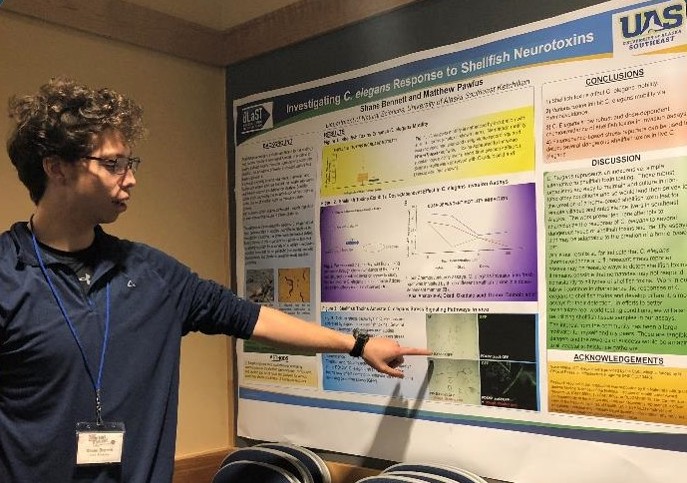How Safe is Our Shellfish? UAS Student and Faculty Research Novel Toxin Testing
Student Shane Bennett has been working with Professor Matthew Pawlus at the University of Alaska Southeast in Ketchikan to explore alternatives to current shellfish toxin testing methods.
Juneau, Alaska

Student Shane Bennett has been working with Professor Matthew Pawlus at the University of Alaska Southeast in Ketchikan to explore alternatives to current shellfish toxin testing methods. Shane is Tlingit, and his family has a long history of utilizing the natural resources of Southeast Alaska including shellfish so his interests in this project were as motivated by his goals of giving back to his community as his interest in biomedical research. Thanks to an undergraduate research grant from UAF’s BLaST program (Biomedical Learning and Student Training) which aims to increase biomedical research opportunities in rural locations and increase diversity in science, Shane was able to initiate a research project during the summer of 2018. Shane is currently pursuing a Bachelor of Science degree at UAF, having earned his Associate of Science degree at UAS.
Toxins generated from several species of marine algae and diatoms pose a prominent health risk to wildlife and human inhabitants of Southeast Alaska. Due to the biological concentration of these algal toxins in the tissues of several shellfish including geoduck, oyster, and mussels, shellfish toxins negatively impact the health of human and marine mammal species that exploit these mollusks as a food source. Although effective methods of detecting shellfish toxins exist, they are labor-intensive and inefficient, requiring potentially toxic samples to be shipped to specialized laboratories for analysis. While the current shellfish testing methods are employed by law by commercial shellfish companies, the time and cost of testing effectively deter the recreational shellfish forager or subsistence-liver from utilizing one of the traditionally important natural resources of Southeast Alaska.
The nematode Caenorhabditis elegans (C. elegans) is a microscopic worm-like creature that normally inhabits common soil. C. elegans have been used extensively for genetic research, are simple to culture, and are extremely sensitive to environmental toxins. Shane’s project tested the hypothesis that C. elegans could be useful as a bio-sensor for detecting shellfish toxins and represent a potential alternative to mouse bio-assays used for this purpose.
The researchers have utilized several techniques in our investigation of C. elegans response to shellfish toxins. So far they have been able to characterize a robust, dose-dependent response of C. elegans to several neurotoxins found in shellfish including toxins responsible for causing amnesic, diarrhetic, and paralytic shellfish poisoning. Work continues on simplifying analytic protocols, extending the utility of the assays to include other toxins and field-testing the assays in real-world conditions. Professor Pawlus notes, “It is our hope that our work might form the basis of a new generation of simple, low-cost, high-sensitivity shellfish toxin assays that could be implemented by local organizations, subsistence and recreational foragers in Southeast Alaska.”
Dr. Tom Thornton, UAS Dean of the School of Arts & Sciences, remarked, “This is a shining example of faculty-student collaboration in basic research of direct significance to Alaskan communities. With environmental changes in Alaska come new challenges, including new species and toxins in the marine food web. This project will improve our testing of shellfish toxins to ensure our food supply is safe.”